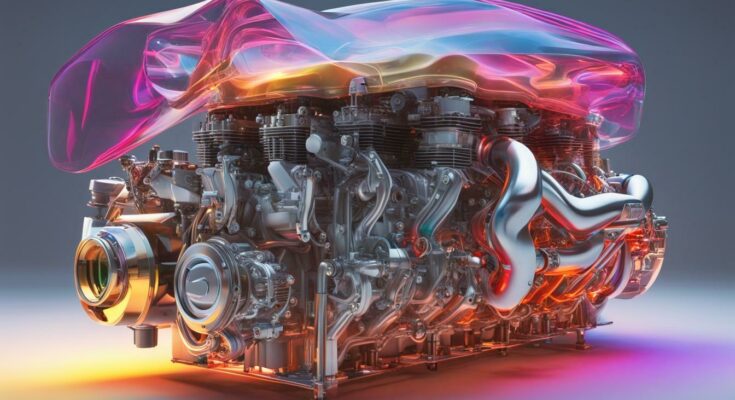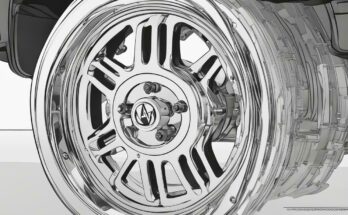If you own a car or are interested in car mechanics, you may have heard the term “manifold” being used. But just what is a manifold on a car? In simple terms, a car manifold is a component that channels air or fuel into an engine’s cylinders. The manifold plays a vital role in the engine’s performance, allowing for optimal combustion and better fuel efficiency.
There are different types of manifolds commonly found in cars, each with its specific purpose and design. The most common types of manifolds on a car are the exhaust manifold and the intake manifold.
Key Takeaways
- A car manifold is a component that channels air or fuel into an engine’s cylinders.
- The manifold is crucial in the engine’s performance, allowing for optimal combustion and better fuel efficiency.
- There are different types of manifolds commonly found in cars, with the exhaust and intake manifold being the most typical.
The Function of Car Manifold: Explained
When discussing the components of a car engine, the manifold is often overlooked, but it actually plays a crucial role in how the engine operates. The manifold on a car is a network of pipes that work to deliver air and fuel to the engine. It is an essential component in the internal combustion process and helps optimize engine performance.
The importance of the car manifold lies in its ability to distribute and mix the air and fuel that is necessary for the engine to function correctly. The manifold ensures that the right amount of air and fuel mixture is delivered to each cylinder, ensuring that the engine runs efficiently and smoothly.
Another important function of the car manifold is to reduce the amount of backpressure that the engine creates. When the exhaust gases from the engine are expelled, they encounter a great deal of resistance as they try to exit the engine. The manifold helps to reduce this backpressure by providing a clear pathway for the exhaust gases to exit the engine.
The car engine manifold can be made from different materials, including steel, cast iron, and even ceramic. The choice of material can impact the performance of the engine and the longevity of the manifold.
In summary, the function of a car manifold is to deliver the correct amount of air and fuel mixture to the engine while reducing backpressure. This optimizes engine performance, ensuring that the engine runs efficiently and smoothly. Given its importance, it is vital to ensure that the car manifold is working correctly and is replaced promptly if any issues arise.
Types of Manifolds on a Car: An Overview
A manifold is an essential component of a car’s engine system that helps optimize performance. There are two main types of manifolds used in vehicles: exhaust manifold and intake manifold. Both play a vital role in the operation of the engine and have unique features that contribute to the performance of the vehicle.
Exhaust Manifold in a Car
The exhaust manifold is an important part of the vehicle’s exhaust system. It is responsible for collecting and expelling the exhaust gases produced by the engine after combustion. The exhaust manifold is typically made of cast iron or stainless steel, which are durable materials that can withstand high temperatures.
The exhaust manifold is designed to be efficient, so it maximizes the engine’s power output. It does this by creating a smooth path for the exhaust gases to flow out of the engine, reducing back pressure which can reduce performance. The exhaust manifold ensures that the exhaust gases are expelled quickly and efficiently, reducing emissions and improving fuel economy.
Intake Manifold in a Car
The intake manifold is responsible for supplying the engine with air and fuel. It is designed to distribute the mixture evenly to each cylinder for optimal combustion. The intake manifold is typically made of aluminum or plastic, making it lightweight and easy to manufacture.
The intake manifold is designed to be responsive and adjust to different driving conditions. It has a variable length, which can change depending on the engine’s RPMs, providing maximum efficiency at different speeds. The intake manifold also has a plenum chamber, which helps distribute the mixture evenly.
Overall, the exhaust manifold and the intake manifold work together to ensure the engine operates efficiently. They play a critical role in the engine system and contribute significantly to the performance of the vehicle.
Signs of a Faulty Car Manifold: What to Look Out For
The car manifold is a crucial component of a vehicle’s engine, and a malfunctioning one can result in significant performance issues. Here are some signs that indicate you may have a faulty car manifold:
- Reduced horsepower: A faulty manifold can cause a decrease in power output, leading to a sluggish engine performance.
- Decreased fuel efficiency: If you notice your car is burning fuel more quickly than usual, a faulty manifold might be the culprit.
- Excessive noise: A leaking or cracked manifold can cause loud noises, particularly during acceleration or when the engine is under load.
- Reduced engine performance: A faulty manifold can cause the engine to misfire or run rough, leading to poor overall performance.
- Check Engine light: In some cases, a faulty manifold can trigger the Check Engine light to turn on, indicating a malfunction in the engine’s system.
If you notice any of these signs, it’s essential to get your car inspected by a professional mechanic to diagnose the issue promptly.
Replacing a Car Manifold
If your car’s manifold is indeed faulty, it’s crucial to have it replaced as soon as possible. Here are some essential steps to keep in mind when replacing a car manifold:
- Remove the old manifold: Carefully remove the bolts and clamps holding the old manifold in place and detach it from the engine.
- Clean the area: Before installing the new manifold, clean the engine’s surface to ensure a tight seal and prevent any leaks.
- Install the new manifold: Carefully place the new manifold in its position and attach it using the appropriate clamps and bolts.
- Check for proper alignment: Once installed, ensure that the manifold is correctly aligned to avoid any leaks or performance issues.
It’s best to leave the replacement job to a professional mechanic unless you have experience working on car engines yourself. A poorly installed manifold can lead to further damage and additional repairs, ultimately costing you more time and money in the long run.
You may like: Understanding What LS Stand For in Chevy Cars & Trucks
Replacing a Car Manifold: Steps and Considerations
If your car’s manifold is faulty, you may need to replace it. Replacing a car manifold is not a simple task and requires some technical knowledge. In this section, we will provide a step-by-step guide to replacing a car manifold and highlight some important considerations to keep in mind.
Step 1: Remove the Old Manifold
The first step in replacing a car manifold is to remove the old one. Begin by disconnecting any electrical connections and removing the bolts and nuts that hold the manifold in place.
Once the manifold is loose, remove it carefully and check for any damage or signs of wear and tear. It’s essential to inspect the manifold gasket and replace it if it’s damaged or worn out.
Step 2: Prepare the New Manifold
Before installing the new manifold, ensure that it’s the correct size and type for your car. You should also inspect it for any damage or manufacturing defects.
Ensure that you have all the necessary tools and equipment for the replacement process, including new gaskets, bolts, and nuts.
Step 3: Install the New Manifold
Carefully install the new manifold in place of the old one, making sure that it’s correctly aligned and positioned. Use the new bolts and nuts to secure the manifold in place, ensuring that it’s not too tight or too loose.
Reconnect the electrical connections and other components that you removed earlier. Double-check that everything is properly connected and secured in place.
Important Considerations
When replacing a car manifold, it’s essential to keep a few crucial considerations in mind:
- Ensure that the replacement manifold is of the correct size and type for your car.
- Inspect the new manifold for any damage or defects before installation.
- Replace the manifold gasket to ensure a tight seal.
- Do not over-tighten the bolts and nuts, as this can damage the manifold or the engine block.
- Ensure that all electrical connections and other components are correctly reconnected and secured in place.
By following these steps and considerations, you can successfully replace a car manifold and ensure optimal engine performance.
Understanding the Significance of a Car Manifold
Now that we have explored what a manifold is on a car and its vital role in the engine’s performance, it’s important to understand the significance of a car manifold. The manifold serves as a connection between the engine and the exhaust system, ensuring the proper flow of air and fuel to optimize the performance of the engine.
The exhaust manifold, in particular, plays a crucial role in removing exhaust gases from the engine, preventing backpressure and promoting better fuel efficiency. On the other hand, the intake manifold helps to regulate the flow of air into the engine, ensuring that the engine runs smoothly and efficiently.
By understanding the different types of manifolds and knowing the signs of a faulty manifold, you can ensure your vehicle operates efficiently. Regular maintenance and timely replacement of faulty manifolds can help prevent more severe engine problems in the future.
Overall, the car manifold is an essential component of the engine that helps optimize its performance and ensure the smooth functioning of the vehicle. By taking good care of your car manifold, you can enjoy better fuel economy, increased power, and improved driving experience.
FAQ
Q: What is a car manifold?
A: A car manifold is a component of the engine that helps regulate the flow of air or gases. It is typically made of metal and is responsible for distributing air or exhaust gases to the engine cylinders.
Q: What is the function of a car manifold?
A: The function of a car manifold is to optimize the performance of the engine. It helps ensure that the correct amount of air or gases are delivered to the cylinders for combustion. This, in turn, improves fuel efficiency and overall engine power.
Q: What are the different types of manifolds on a car?
A: There are two main types of manifolds on a car: the exhaust manifold and the intake manifold. The exhaust manifold collects exhaust gases from the engine cylinders and directs them to the exhaust system. The intake manifold, on the other hand, delivers fresh air or air-fuel mixture to the cylinders.
Q: What are the signs of a faulty car manifold?
A: Some common signs of a faulty car manifold include decreased engine performance, unusual noises from the engine, and the presence of exhaust leaks. If you notice any of these symptoms, it is important to have your manifold inspected and repaired or replaced if necessary.
Q: How do I replace a car manifold?
A: Replacing a car manifold is a complex task that requires technical knowledge and expertise. It is recommended to have a professional mechanic handle the replacement process to ensure it is done correctly. They will assess the condition of the manifold, remove the old one, and install a new manifold according to the manufacturer’s specifications.



